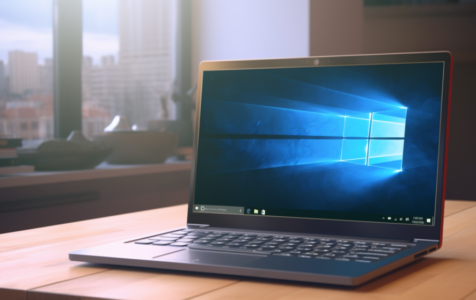This guide provides step-by-step instructions for clearing cache files in Windows 10. It includes four key parts:
- Clearing cache and cookies in your web browser
- Clearing system cache and temporary files in Windows 10
- Handling specific types of cache like those for the Windows Store and DNS
- Taking extra steps like setting up a system restore point and using third-party cleaning tools.
Summary Table
The Summary Table serves as a quick reference guide to the different methods for clearing cache in Windows 10, as detailed in the article. This table helps you understand which method is best suited for your needs and how cautious you should be while performing each task.
| Type of Cache | Method | Risk Level |
|---|---|---|
| Browser Cache | Browser Settings | Low |
| System Cache | Disk Cleanup | Medium |
| DNS Cache | Command Prompt | Low |
| Third-party Tools | Software | Varies |
Clearing Browser Cache and Cookies
What are cache and cookies? They’re temporary data that your web browser stores to load websites more quickly. Over time, this data can take up space and even slow down your browser.
How to Clear Cache and Cookies in Google Chrome
- Launch Google Chrome.
- Click on the three-dot icon located at the upper-right corner.
- Go to
More tools > Clear browsing data. - In
Time range, selectAll time. - Check the box next to
Cached images and files. - Confirm by clicking the
Clear databutton.
For Other Browsers
If you use Safari, Firefox, or another browser, consult their support sites for specific guidelines on clearing cache and cookies.
Expert Tip: For smoother PC performance, consider using a PC optimization tool. It handles junk files, incorrect settings, and harmful apps. Make sure it's right for your system, and always check the EULA and Privacy Policy.
Special offer. About Outbyte, uninstall instructions, EULA, Privacy Policy.
Clearing System Cache and Temporary Files
“System cache and temporary files serve a similar purpose to web cache but for your entire computer. These files speed up processes but can clog up your system over time.
Quick Cleanup of Temporary Files in Windows
- Press
Windows + Rto open the Run dialog. - Type
%temp%and clickOK. - Select and Delete files and folders.
Deep Cleanup Using Windows Settings
- Right-click the Windows Start button.
- Choose
Settings. - Click
Systemand then theStoragetab. - Follow the on-screen instructions after clicking
Free up space now.
Advanced Cleanup with Disk Cleanup Utility
- Press
Windows + Sand typeDisk Cleanup. - Select your preferred drive and click
OK. - For a more thorough cleanup, click
Clean up system files. - Check the desired items to delete and finish by clicking
OK.
Clearing Windows Store Cache and DNS Cache
The Windows Store Cache is specific to the Windows Store app. The DNS cache helps your computer find websites but sometimes can cause errors.
Clear Windows Store Cache
- Open the Run dialog by pressing
Windows + R. - Enter
wsreset.exeand clickOK.
Flush DNS Cache
- Open Command Prompt as an administrator.
- Type
ipconfig/flushdnsand pressEnter.
Creating a System Restore Point
You can use a System Restore Point to roll back changes if something goes wrong.
Creating a System Restore Point
- In the search bar, type
restore. - Click
Create a restore point. - In the
System Protectiontab, select your system drive. - Click
Deleteto remove previous restore points, if desired.
Read our detailed guide on this process: How to Create a Restore Point.
Third-Party Cleanup Tools
Third-party tools offer more ways to manage and remove temporary files from your computer.
- Outbyte PC Repair:
- This software can scan for issues like redundant files, system cache, and temporary internet files.
- Review the scan results and choose which files or issues you want to address.
- Follow on-screen instructions to complete the cleanup process.
- MiniTool Partition Wizard:
- This tool includes a
Space Analyzerto help you identify unnecessary files. - Pick a drive to analyze and click
Scan. - Delete unnecessary files after scanning.
- This tool includes a
- CCleaner:
- This application allows you to analyze and remove unnecessary files.
- Click ‘Analyze’ to identify files that can be deleted.
- After analysis, click on ‘Run Cleaner’ to remove the selected files.
By including various third-party options such as MiniTool Partition Wizard and Outbyte PC Repair, you can choose the tool that best suits your needs for maintaining a clean, optimized system.
Conclusion
This guide offers a structured approach for managing and deleting cache files in Windows 10. The guide covers four critical areas:
- Web Browser Cache and Cookies: Specifically shows steps for Google Chrome, with advice for those using other browsers.
- System Cache and Temporary Files: Explains quick and advanced ways to remove system-level cache that could bog down your machine.
- Specialized Cache: Discusses cleaning up unique caches like Windows Store and DNS cache, which have their own sets of rules and locations.
- Extra Considerations: Introduces the concept of System Restore Points and suggests third-party cleanup tools, each with their own specific functionalities.
By adhering to these guidelines, you’ll be better equipped to maintain a cleaner, faster, and more efficient computer. With options ranging from built-in Windows utilities to specialized third-party tools like Oudbyte PC Repair and CCleaner, this guide provides a variety of methods for achieving a more optimized system.
Please Note:
This guide aims to help you manage and clear cache in Windows 10. Back up your important data before making changes. If you encounter issues not addressed in this guide, seeking professional advice is recommended
